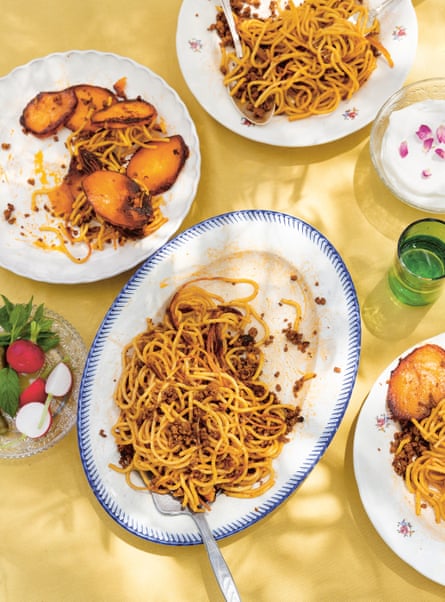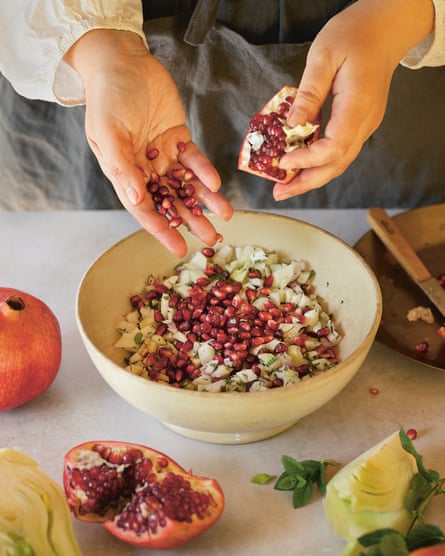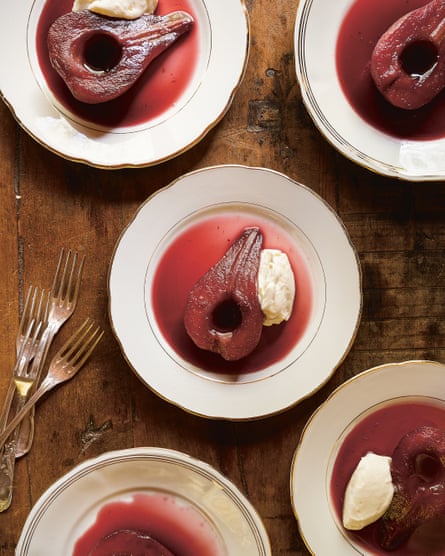
The unthinkable Iranian ‘makaroni’
ماکارونی
Some time in recent history, the modern form of Italian-ish pasta found its way into Iran. However, it’s a mistake to think that Iranians have been strangers to noodles and pasta in general.
In fact, one of the oldest written records of noodles is lakhsha, known in eastern parts of Iran and Afghanistan as lakhshak, supposedly “invented” by the Sasanian king Khosrow. The same word travelled to Central Asia and Eastern Europe, becoming lapsha in Russia and laska in Hungary, both meaning “noodles”.
In Iran, any pasta in general is now called makaroni in domestic use. The typical makaroni sauce is definitely inspired by a classic bolognese, but somewhere along the way it has been tamed and domesticated to fit the Iranian palate, with so much golden onion, a touch of turmeric, cinnamon and saffron, and only just a hint of tomato paste.
The trick is to undercook the pasta in the first step (the parboiling) so that it won’t be overcooked after the long second stage (the steaming).
This was a kids’ favourite when I went to school and – brace yourself – we ate it with huge spurts of ketchup. I won’t judge you if you do the same. It’s an Iranian makaroni, after all.
Serves 4
350g spaghetti or spaghettoni
For the sauce
3 tbsp vegetable oil
1 tbsp golden onion (see below)
300g minced meat
¼ tsp ground turmeric
¼ tsp ground cinnamon
4 tbsp tomato paste
200ml hot water (from a kettle)
1 tsp saffron infusion (see below)
½ tsp salt
¼ tsp freshly ground black pepper
For steaming the pasta
1 tbsp ghee (or half butter, half vegetable oil)
1 potato, peeled and sliced crossways into 5mm discs, kept in a bowl of water to avoid oxidation
Begin with the sauce. Heat the oil in a large heavy-based saucepan with the golden onion. Next, brown the meat over medium–high heat for about five minutes, until no pink parts are left. Add the turmeric and cinnamon and cook for another few minutes, then stir in the tomato paste and cook for about five minutes, or until the tomato paste brightens in colour. Pour in the hot water, reduce the heat to low and cook with the lid on for 15 minutes.
Stir in the saffron infusion and salt, then adjust the seasoning to taste. This sauce will have very little liquid and should not be as saucy as an Italian ragu. Set aside.
Meanwhile, bring a large heavy-based nonstick pan of water to the boil and season with salt. Add the pasta and cook for about half the time indicated on the packet. Drain the pasta and, in the same pan, bring the ghee and 200ml water to the boil. Set aside half of this oily water in a cup.
Cover the bottom of the pan with the potato discs to make tahdig (the prized scorched rice at the bottom of the pan). Then add one layer of spaghetti on the potato slices, then top with one layer of the meat sauce. Repeat until you run out of both, then pour the rest of the oily water over the top.
Put the lid on and cook over high heat for seven to 10 minutes. Reduce the heat to the lowest setting (on a heat diffuser, if you have one), wrap the lid in a clean cotton tea towel, place it snugly on the pan and cook for about 30 minutes to one hour.
Gently mix the pasta with the meat mixture and serve immediately, scraping the tahdig off the bottom of the pan with a wooden spatula.
Golden onion
Piaz dagh | پیاز داغ
It’s very handy to have golden onion at the ready when you’re cooking Iranian dishes, so making a bigger batch is a good solution. It takes some time to slice and fry all the onion, but it will keep in the fridge for a couple of days and you can also freeze some (in one layer, that’s the key).
Makes 2 tbsp golden onion
Oil, for deep-frying (the quantity will depend on the size of your pan)
2 onions, halved, then sliced 5mm thick
¼ tsp ground turmeric
In a large pan suitable for frying, heat the oil over medium–high heat. Make sure the onion half-rings are separated from each other. When tiny bubbles appear in the oil, add one slice of onion to check the heat. If the oil around the onion bubbles and the onion comes to the surface, the oil is hot enough; otherwise, wait until this happens.
Usually, two sliced onions can be fried in two or three batches, in a 23cm pan. If your pan is smaller, you should fry the onions in more batches. This is actually time saving, contrary to what you may think, because one layer of onion fries more quickly, and piled-up onions become soggy and take more time to become golden and crunchy.
Fry each batch over medium–high heat for about eight to 12 minutes, or until the onion has shrunk down and is completely golden. At the last moment for the first batch, add all the turmeric, stir around a bit, then with a slotted spoon transfer the onion to a large dish lined with paper towel. The onion will darken once removed from the pan, turning golden brown on the paper. Add another batch of onion to the pan and repeat. For this amount of onion, the turmeric added to the oil at the end of the first batch is enough. (If you’re making more than this amount, add a dash more turmeric each second or third batch.) You can keep the frying oil for a week for frying up more golden onion, or to use in dishes where a hint of onion and turmeric would be welcome.
Saffron infusion
Za’feran-e dam kardeh | زعفران دم کرده
Infusing is the technique we use in Iran to prepare saffron for all our dishes, both savoury and sweet. We call this infusing “brewing” in Persian – the same verb we use for preparing tea and steaming rice. I know there are other methods of preparing saffron as well, but please, whatever you do, don’t use the saffron threads dry and on their own. It’s unforgivably wasteful, because its exquisite flavour and colour are released much better when the threads are infused in warm water. It’s also way too expensive to just sprinkle dry saffron threads on top of dishes, not to mention also a bit obnoxious – especially to those hands that collected those flowers one morning at sunrise in the east of the world.
Makes 3 tbsp saffron infusion
½ tsp saffron threads, very loosely packed
A good pinch of sugar
Grind the saffron strands with the sugar in a small mortar. If you don’t have a small mortar, you can put the saffron and sugar on a piece of baking paper, fold all the sides so the powder won’t escape, then grind with a jam jar or rolling pin until you have a very fine powder.
Boil the kettle then let it sit for a few minutes. Tip the powder very gently into a small glass teacup then gently pour three tablespoons of the hot water over it. (Never use boiling water or you’ll “kill” the saffron.) Cover the cup with a lid or saucer and let the mixture “brew” for at least 10 minutes without removing the lid to release the colour and aroma of the saffron. After this time your saffron infusion is ready to use.

Unorthodox Iranian salad, for winter
Salad Shirazi | سالاد شیرازی
The humble salad Shirazi is an essential part of an Iranian table, comprising cucumber, tomato, onion, salt and some acid – preferably verjuice, which we love in Iran. Unfortunately in winter, the classic salad Shirazi tastes horrible because out-of-season tomatoes and cucumbers taste horrible. However, I just can’t fathom a proper Iranian table without this salad on it, so I came up with this winter version, which is inauthentic but utterly delectable. The ruby red pomegranate seeds make up for the acidity of bright red tomatoes, and the texture and anise-like aroma of fennel stand in beautifully for the aromatic crunch of cucumbers.
Makes 1 medium bowl of salad
1 fennel bulb, trimmed and diced into 1cm pieces
1 small red onion, diced
Seeds of ½ pomegranate
1½ tsp dried mint, or a handful of fresh mint leaves, finely chopped
2 tbsp lemon or lime juice
1 tsp salt
Combine all the ingredients in a bowl and serve.
Pears poached in wine with mascarpone cream

Like many Iranians before me, I have been raised with the idea that certain foods are “cold” and “moist” and need to be accompanied by “warm” and “dry” foods, and vice versa. For example, we wouldn’t serve fish with yoghurt on the side – indispensable as yoghurt is on the Iranian table – because they are both “cold”.
These unwritten rules that we know by heart and apply to our cooking as part of our culinary identity are relics of traditional medicine from the Middle Ages, practised by Persian physicians such as Avicenna, who in turn drew on the teachings of the ancient Greek physician Galen, who categorised nature, people, food and plants into the four “humours” of cold, warm, moist and dry.
In premodern Europe too, these same medical principles were applied to diet and food combinations. The idea was to “correct” each food with cooking and pairings so they would be balanced. Although more of a French custom, cooking fruit (“cold” and “moist”) in wine (“warm” and “dry”) had the same notion behind it.
And that’s how we got these pears, looking sexy and French in their flamboyant and glossy red wine sauce, with a luscious mascarpone cream on the side. Admittedly, the medieval ones couldn’t have been this extravagant.
Serves 8
4 beurre bosc pears, or other pears suitable for cooking
1 cup red wine (250ml)
120g sugar
2 bay leaves
1 cinnamon stick
For the mascarpone cream
400g mascarpone (can be substituted with cream)
2 tbsp sugar
4 tbsp Marsala (can be substituted with port)
Peel the pears and cut in half. Use a teaspoon to remove the seeds and core from each pear half, leaving a nice round hollow.
In a saucepan wide enough to fit all the pear halves, heat the wine with the sugar, bay leaves and cinnamon stick, stirring to dissolve the sugar. When it comes to a gentle simmer add the pears, rolling them in the wine so that all parts are tinged with the wine.

Cover and cook over medium heat for 10 minutes. Remove the lid and simmer, uncovered, for another 20 to 30 minutes, until the wine has reduced and is a little syrupy. Leave to cool.
Before serving, whip or mix the mascarpone cream ingredients together until smooth. Serve the pears with a generous dollop of mascarpone cream, drizzled with the syrupy wine.
-
This is an edited extract from Pomegranates & Artichokes by Saghar Setareh, available in Australia through Murdoch Books ($49.99).



